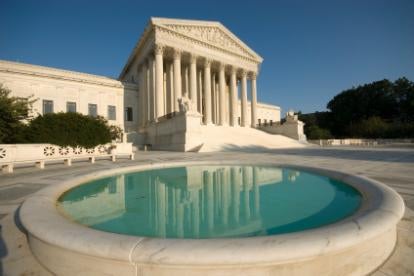In a unanimous decision issued on June 12, 2017, the Supreme Court for the first time interpreted key provisions of the 2010 Biologics Price Competition and Innovation Act (“BPCIA”). See Sandoz Inc. v. Amgen Inc., No. 15-1195 (U.S. June 12, 2017). The Court’s decision grants more flexibility to biosimilar companies and filers of abbreviated Biologics License Applications (“aBLAs”), holding that (1) a reference product sponsor is not entitled to injunctive relief under federal law for an applicant’s refusal to provide a copy of its aBLA and manufacturing information during the information exchange period contemplated by the BPCIA, and (2) an applicant may provide statutory 180-day pre-launch notice of commercial marketing before its proposed biosimilar product is licensed by FDA. An overview of the parties’ oral arguments before the Court on these issues can be found here.
The Federal Circuit Holdings on Appeal to the Supreme Court
The Amgen v. Sandoz proceedings arose out of Sandoz’s filing an aBLA with FDA to market a biosimilar version of Amgen’s approved Neupogen (filgrastim) biologic. As we previously discussed, the Federal Circuit opinion below had held that:
-
aBLA applicants do not violate the BPCIA by “opting out” of the BPCIA’s “patent dance” information exchange procedures and choosing not to provide a reference product sponsor, like Amgen, with a copy of their aBLAs and manufacturing information as described in 42 U.S.C. § 262(l)(2)(A); and
-
aBLA applicants may not provide the reference product sponsor with 180-day pre-launch notice of commercial marketing pursuant to 42 U.S.C. § 262(l)(8)(A) until after FDA approves the biosimilar product.
The Supreme Court affirmed the Federal Circuit on the first issue, albeit on different grounds, and reversed on the second issue.
The BPCIA “Patent Dance” Information Exchange is Optional, and a Biosimilar Manufacturer’s Failure to Participate is Not a Violation of the BPCIA
The Supreme Court affirmed the Federal Circuit by holding that a reference product sponsor may not pursue an injunction under federal law if the aBLA applicant refuses to engage in the BPCIA’s “patent dance” information exchange. Specifically at issue was § 262(l)(2)(A) of the BPCIA, which instructs that an aBLA applicant “shall provide to the reference product sponsor a copy of the [aBLA] application” and information describing the biosimilar product manufacturing processes.
Despite agreeing with the Federal Circuit’s holding on this question, the Supreme Court took issue with the Federal Circuit’s reasoning. An applicant’s failure to comply with § 262(l)(2)(A), the Court held, is not an act of artificial infringement under 35 U.S.C. § 271(e)(4). Instead, such failure simply provides the reference product sponsor with a different and exclusive remedy under § 262(l)(9)(C). That section allows the sponsor to bring an immediate declaratory judgment action for patent infringement under § 271(e)(2)(C)(ii). No injunctive relief is permitted under the BPCIA for such an act. The Court also observed that in contrast with § 262(l)(2)(A), a different provision of the BPCIA, § 262(l)(1)(H), expressly allows for an injunctive remedy. Thus, the Court held, Congress clearly knew how to provide for injunctive relief in the event of an applicant’s failure to follow BPCIA provisions, but deliberately chose not to provide such relief when an aBLA applicant fails to engage in the § 262(l)(2)(A) information exchange.
While the biosimilar applicant may refuse to participate in the § 262(l)(2)(A) information exchange without subjecting itself to an injunction, that refusal is not without consequence. For example, the reference product sponsor’s ability to bring a declaratory judgment action under § 262(l)(9)(C) on “any patent that claims the biological product or a use of the biological product” is no longer limited to the applicant-controlled “list” of patents. The reference product sponsor, and not the biosimilar applicant, is thus more able to control the scope and timing of the ensuing patent litigation.
The Court remanded to the lower courts to determine whether failure to engage in the § 262(l)(2)(A) information exchange is “unlawful” under California’s unfair competition law. The Court offered no opinion on that issue of state law, but did vacate the opinion below because it improperly considered only the BPCIA, rather than California law.
aBLA Applicants May Provide 180-day Notice of Commercial Marketing BeforeFDA Approves a Biosimilar Product
The Court also reversed the Federal Circuit by holding that an aBLA applicant need not wait until FDA actually licenses a biosimilar product before providing the reference product sponsor with the 180-day notice of commercial marketing required under § 262(l)(8)(A). Rejecting Amgen’s proposed statutory construction, the Court based its holding on the fact that the plain language of § 262(l)(8)(A) imposes only a single timing requirement, namely to provide notice at least 180 days before first commercial marketing. Section 262(l)(8)(A) makes no reference to the date of FDA biosimilar licensing, the Court held, and thus does not require that notice only follow FDA approval. Once again, the Court pointed to language elsewhere in the BPCIA to establish that Congress knew how to impose such a requirement but deliberately chose not to in this case. For example, § 262(l)(8)(B) plainly allows a preliminary injunction suit after receiving notice and before first commercial marketing.
The Court recognized that policy considerations support arguments for and against requiring biosimilar approval before allowing the 180-day notice, but noted that even persuasive policy considerations must take a backseat to the BPCIA’s “plain language” in this case.
Supreme Court Provides Some Clarity, But BPCIA Litigation Likely to Continue
The Supreme Court’s ruling clarifies that aBLA applicants may completely refuse to engage in the BPCIA’s “patent dance” information exchange, and need not wait for FDA approval of the biosimilar product before providing the reference product sponsor with 180-day notice of commercial marketing.
It remains to be seen how aBLA applicants and reference product sponsors will respond to the Court’s ruling. The 180-day notice ruling, for example, will likely have a significant impact on the timing of the “second phase” of BPCIA litigation. For many biologic products, this means the first and second “phases” of BPCIA litigation may be effectively merged. But not all applicants may wish to engage in litigation on all of a sponsor’s listed patents any earlier than necessary.
Moreover, as Justice Breyer’s concurrence explains, even the issues resolved by the Court’s ruling may not stay settled for good. Justice Breyer wrote separately to point out that FDA may, after “greater experience administering” the BPCIA, have authority to depart from or modify the Court’s interpretation.
Stay tuned for further coverage of this and other BPCIA issues making their way through the courts.




 i
i


